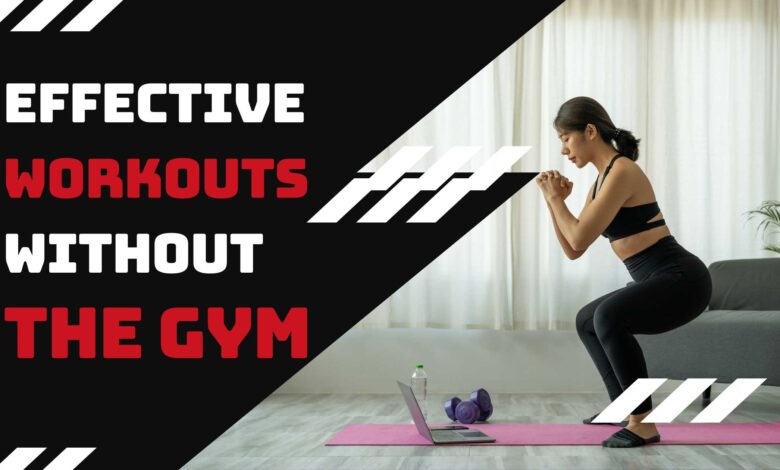Fitness at Home: Effective Workouts Without the Gym

The world of fitness has changed dramatically in recent years, with more and more people choosing to work out at home rather than going to the gym. The convenience, cost-effectiveness, and ease of home remedies make it an attractive option for many people. In addition, the advancement of technology and the abundance of fitness resources are making it easier to maintain a good exercise routine without leaving the house. This article discusses the benefits of working out at home, discusses effective forms of exercise, and provides tips for creating a home fitness program.
Table of Contents
1) Benefits of Exercising at Home:
Exercising at home has many benefits and can be adapted to a variety of lifestyles and needs. First, they provide unparalleled comfort. You can exercise whenever it suits your schedule, there is no need to go to the gym. This flexibility is very useful for busy professionals, parents, and anyone who lives a busy life.
Second, exercising at home can save money. Gym memberships and personal trainer fees can add up quickly, but the equipment required by the workouts is minimal. There are many very effective exercises that require no equipment and rely solely on weighted movements.
In addition, exercising at home is a private and comfortable space, which is especially attractive for those who know how to exercise in front of other people. This privacy can help individuals feel comfortable and motivated to maintain a fitness routine.
2) Types of Effective Home Exercises:
There are many types of exercises that you can do at home, which focus on different aspects of the body such as strength, endurance, flexibility and balance. Here are some very useful things to do at home:
Bodyweight Exercises: These exercises use your body weight as resistance and are great for home workouts. Examples include push-ups, squats, lunges, planks, and burpees. There are many physical exercises that can be modified according to fitness levels.
Cardio: Cardio exercises can be done at home without equipment. Activities such as jumping jacks, leg lifts, mountain climbing, and jogging will increase your heart rate and improve your cardiovascular health. Dancing, climbing stairs, and jumping rope are also good aerobic exercise options.
Strength training: Strength training can be done with dumbbells, resistance bands, and even household items like water bottles and flasks. Exercises such as bicep curls, tricep dips, shoulder presses, and leg lifts help strengthen the muscles.
Yoga and Pilates: These low-impact exercises focus on flexibility, core strength and mental health. There are many online platforms that offer yoga and Pilates classes for all ages, which you can practice in the comfort of your home with just a mat.
HIIT (High Intensity Interval Training): HIIT workouts are short bursts of intense exercise followed by short rest periods. These exercises are great for burning calories and improving heart health in the short term. A HIIT routine can include a combination of bodyweight and cardio exercises.
3) Develop a Home Fitness program:
In order for home workouts to be effective, it’s important to establish a regular, consistent fitness program. Here are some tips:
Set Simple Goals: Set your fitness goals, whether it’s weight loss, muscle building, endurance, or flexibility. Clear goals will help you stay motivated and track your progress. Create a dedicated space: Designate a dedicated space in your home for exercise. The room should be free of distractions and large enough to allow easy movement. Having a dedicated training session can help you get the right mindset for exercise.
Follow a routine: Consistency is key to achieving your fitness goals. Schedule regular training sessions, like other important events. Aim for at least 150 minutes of moderate aerobic activity or 75 minutes of vigorous activity per week, with two strength training sessions per week.
Use online resources: Use the wealth of online fitness resources. Platforms like YouTube, fitness apps, and virtual classes offer a variety of workouts led by professional trainers. These resources can lead, differentiate, and motivate.
Be responsible: Find ways to take care of yourself. This could be recording your workouts in a diary, joining an online fitness community, or working out with virtual friends. Accountability helps maintain learning and encourages persistence.
Listen to your body: Pay attention to how your body feels during and after exercise. Rest is important for recovery, so don’t push yourself to injure yourself. Warm up before exercise and cool down after exercise to prevent muscle strain.
Also Read: Beauty Secrets: 10 Skincare Tips for a Radiant Glow
Conclusion
Exercising at home is a practical and effective alternative to traditional gym training. By taking advantage of the convenience, cost savings, and convenience of working out at home, you can achieve your fitness goals without ever stepping foot in the gym. From bodyweight exercises and cardio to yoga and strength training, there are many types of exercises that can be done with little or no equipment. Establishing daily routines, using online resources, and staying accountable are important parts of a home fitness program. With the right approach, you can maintain a healthy and active lifestyle from the comfort of your own home.




